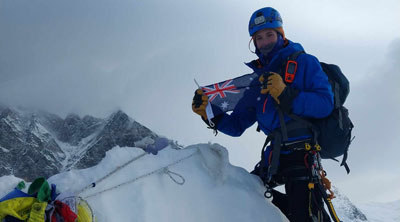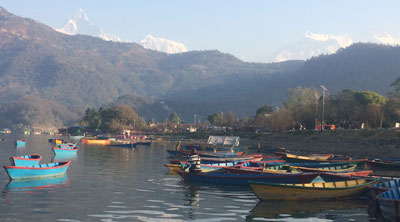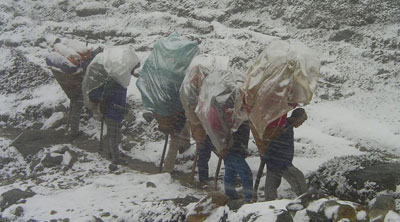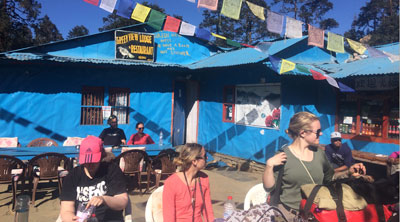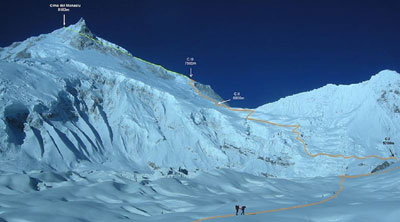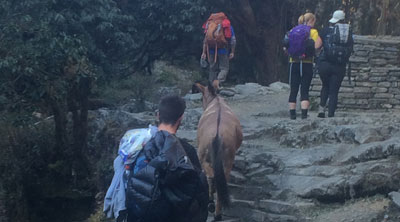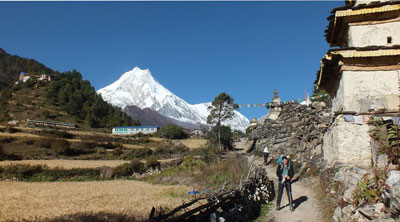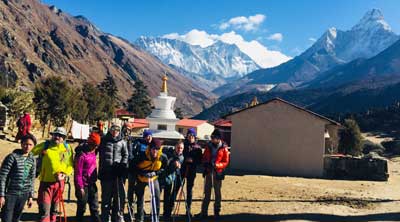Highest glacier on Mt Everest is melting
Human-induced climate change is causing the highest glacier on Mt Everest to melt at a rapid pace which may lead the South Col Glacier to be completely wiped out by the middle of the current century, a new study has found.
The study, published in Nature Portfolio Journal Climate and Atmospheric Science, revealed that the South Col Glacier, which sits around 7,906m (25,938 ft) above sea level, has lost as much as 55m of thickness in the last 25 years.
It is thinning over 80 times faster than the 2,000 years it took to form the ice, according to the study conducted by researchers led by the US-based University of Maine.
A team of scientists and climbers, including six from the University of Maine, visited the glacier in 2019 and extracted samples from a 10-metre-long (around 32 feet) ice core. They also installed the world's two highest automatic weather stations to collect data and answer a question whether the earth's most out-of-reach glaciers were impacted by human-linked climate change.
“The answer is a resounding yes, and very significantly since the late 1990s,” Paul Mayewski, the expedition leader and the director of the Climate Change Institute at the University of Maine, told CNN.
Researchers noted that the glacier's thick snowpack has been eroded, exposing the underlying black ice to the sun and accelerating the melting process. This transformation from snowpack to ice means the glacier can no longer reflect radiation from the sun, making it melt more rapidly.
According to the study, the transition from a permanent snow/firn surface to majority ice-cover could have been triggered by climate change since 1950, with sublimation enhanced by rising air temperatures playing the critical role. “But the ice loss has been most intense since the late 1990s,” the report states.
“At an estimated thinning rate approaching 2,000 mm (2m) annually, even glaciers such as South Col Glacier that are above 8,000m may disappear by mid-century.”
The finding of the new study is consistent with the conclusion of a team of French researchers who found that the world's glaciers are melting at an accelerating rate.
According to a BBC report, researchers found glaciers to have lost almost 270 billion tonnes of ice a year over the opening two decades of the 21st Century. The meltwater produced now accounts for about a fifth of global sea-level rise, the scientists told Nature journal.
The worldwide retreat of mountain glaciers in recent decades is well documented and this study has further reinforced the impact of climate change on the Himalayan mountains, according to the experts.
“The findings of the new study show there has been a massive impact of climate change in our Himalayas,” said Manjit Dhakal, a climate change expert. “We can generalise that the glaciers in other Himalayan mountains are also depleting fast.”
A study published in Nature in August 2020 showed that glacial lakes are rapidly growing in response to climate change and glacier retreat. The global glacier lake volume increased by around 48 percent to 156.5 km, between 1990 and 2018, according to the study.
As the glaciers in the Hindu Kush Himalaya Region are melting fast, the trend will continue in the days to come, according to a study released in February 2019. The Hindu Kush Himalaya region runs from Afghanistan to Myanmar and is the planet’s “third pole.”
“Even if carbon emissions are dramatically and rapidly cut and succeed in limiting global warming to 1.5 degrees Celsius, 36 percent of the glaciers along the Hindu Kush and Himalaya range will have gone by 2100,” says a study report of International Centre for Integrated Mountain Development tilted “The Hindu Kush Himalaya Assessment”. “If emissions are not cut, the loss soars to two-thirds," the report found.
If the global temperature rise is 2 degrees Celsius, half of the glaciers are projected to melt away by 2100, according to the report.
Climbers have already seen the visible impact of retreating snowpacks in Nepal's Himalayan mountains.
“Nowadays we observe more rocks in the Himalayan mountains and rock falls instead of snow falling down,” said Kami Rita Sherpa, a mountain guide who broke his own record by climbing the world's tallest mountain for the 25th time in May last year.
He said that growing portions of rocks in the mountain could affect the future expeditions to the mountain because the climbers could face more exposed bedrock and ice cover, making it difficult to climb the Himalayan mountains.
“The clothes and other instruments to climb the rocks and snowy mountains are different and more rocks in the mountain means our clothes and equipment meant for snowy mountains may not work during the expedition,” Sherpa told the Post.
The veteran climber said that particularly the new climbers would find it difficult to climb the mountains due to the growing presence of rocks replacing the snow. The concern of the veteran climbers has also been shared by the new study as it warned of the danger to climbers of Mt Everest due to warm and thicker air.
“As loss of high elevation snow and ice cover continues to thin exposing bedrock; warm thicker air increases oxygen availability; ice block movement in the Khumbu icefall and avalanches becomes even more dynamic; and glacier melt destabilises the Khumbu base camp that is home to 1,000 climbers and logistics teams during the climbing season,” the new report says.
Besides the potential impact of melting glaciers on the climbers, it could have had a massive socio-economic impact on this region, according to researchers and climate change experts.
Mayewski also told the BBC that he observed that the rapid melting could have a wide variety of “significant regional to global scale implications”.
Around one billion people depend on the Himalayan mountain range for drinking water, and if other glaciers in the region—and worldwide—follow Everest's example, their capacity to provide water for drinking and irrigation could fall significantly, according to a BBC report.
Dhakal said that the finding of the latest study is a cause for concern for Nepal whose economy and the livelihoods of many people could be badly affected by the loss of snow in the mountain.
“Hydropower is one of the pillars of Nepal’s economy,” said Dhakal. “If the water level in rivers decreases due to decreasing snow in the mountain, hydropower projects cannot produce electricity as estimated, affecting the power supply,” he said.
Most of Nepal’s hydropower projects are run of the river type and their production capacity slumps along with depleting water levels in the winter.
“The agriculture sector will also surfer due to the lack of adequate water for irrigation.” said Dhakal.
Despite the visible impact of climate change and potential catastrophic impact on the world in the future, world leaders are yet to agree on a binding commitment to reduce emission of carbon dioxide—a greenhouse gas which accelerates climate change.
During the United Nations Climate Change Conference held in Glasgow, Scotland in November last year, world leaders agreed to meet next year again to pledge further cuts to emissions of carbon dioxide. They also agreed to phase down coal use, cut subsidies in fossil fuels and increase monetary support to poor countries to cope with the effects of climate change.
“We have to reduce the use of fossil fuel, coal and increase use of renewable energy,” said Dhakal, “to reduce the emission and address the climate change crisis.”
The study, published in Nature Portfolio Journal Climate and Atmospheric Science
News by Prithvi Man Shrestha,
The Kathmandu post on 6th Feb 2022

